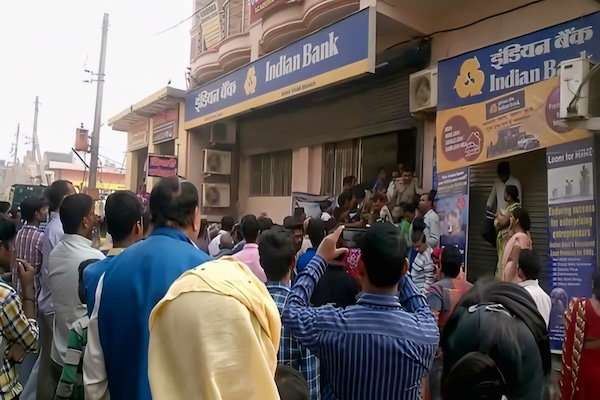.png)

Anupam Sonal, a career central banker with 34+ years’ experience in regulation, supervision, customer protection and fintech, is currently a Senior Advisor and Independent Director to banks & NBFCs.
September 23, 2025 at 6:57 AM IST
The Manthan 2025 conclave, convened by the Department of Financial Services this September, concluded with ambitious proclamations for public sector banks. Among the headline targets is the aspiration to see at least two Indian lenders break into the world’s top twenty by 2047, aligned with the broader vision of Viksit Bharat 2047. Yet behind the rhetoric lies a hard truth: what sustains a bank is not its size, product range, or digital sophistication. It is the customer.
Banks are fiduciary institutions built on public trust. They mobilise household savings and channel them into intermediation and maturity transformation. Their ultimate resource is not technology or ideology but credibility. Indian banks have travelled far, deepening reach, diversifying offerings, and embracing digital-first models. But in this surge toward automation and AI, the customer is too often an afterthought. The macro story celebrates digitisation, while the micro reality is littered with avoidable service breakdowns.
Everyday Failures
Recent personal experiences with two super seniors across multiple banks, public and private, expose how fragile service quality remains. A 96-year-old was told to appear in person for fingerprint authentication because no staff could be spared for a home visit.
Passbooks went weeks without updates because printers remained out of order, while updating KYC records and removing deceased account holders became an endless loop of misplaced papers and repeated submissions.
Some branches bluntly advised: close the account and start afresh.
In one case, an account has remained partially frozen for over a year because the system continues to link it with the deceased joint holder. Even a newly-issued cheque book carried the dead person’s name. At another branch, customers were told only the “home branch” in another city could resolve issues, an absurdity in the age of anywhere core banking. These are not isolated anecdotes. Conversations in waiting halls revealed similar frustrations, pointing to a pervasive malaise. If such basic processes drag for months, what confidence can one have in the resilience of more complex operations?
However, not all encounters were so grim.
At one branch of a private bank, the contrast was striking. The staff were courteous, systems worked smoothly, and issues were resolved within hours. Confirmations were sent by email the same day, follow-up queries were answered on the phone, and repeat visits were avoided. Prior interactions confirmed that this was not luck, but rather a matter of culture. The lesson is obvious: good service is possible. It is neither utopian nor prohibitively expensive. It is a matter of institutional consciousness, consistent processes, and respect for customers.
Intent Vs Delivery
Over two decades, the Reserve Bank of India has built an elaborate framework for consumer protection. The Charter of Customer Rights of 2014 affirms fairness, transparency, suitability, privacy, and redress. The Fair Practices Code and Master Circular on Customer Service set operational standards. The Integrated Ombudsman Scheme of 2021 unified grievance redress across banks, NBFCs, and payment systems. Internal ombudsmen now provide a mandatory pre-RBI escalation step. Product-specific circulars embed service safeguards, while governance and risk mandates weave these standards into supervisory oversight.
In theory, these instruments should ensure every interaction is efficient, respectful, and timely. In practice, the reality is different. The incidents above demonstrate that regulatory intent has not been effectively translated into operational delivery. Failures stem from structural neglect.
Governance still treats customer service as cosmetic and peripheral. Fragmented digital and manual processes trap customers in cycles of resubmission. Risk and audit frameworks rarely treat service quality as systemic risk, though its reputational fallout can be as damaging as a credit crisis. Branches remain understaffed, morale is thin, and customer experience is captive to overburdened employees.
This is not uniquely Indian. Globally, lessons converge. The OECD (2020) has noted that empowered, motivated frontline staff are the strongest predictors of service quality. Where institutions invest in their people, outcomes improve. Where they do not, even the most sophisticated systems fail.
Pathways Forward
If Indian banks are to align ambition with reality, the roadmap is not about reinventing the wheel but executing what is already known. International practices, including the OECD principles of 2022 and RBI guidelines, point to practical steps. Governance must come first. Board-level committees should treat service lapses as systemic failures, pursue root-cause probes, and drive transformation. Metrics should go beyond counting complaints to track closure times, escalation-free resolutions, and zero-visit outcomes.
Auditable turnaround times tied to accountability and incentives must be enforced to minimise harassment. Service playbooks integrated into core systems, aided by AI, can arm staff with reliable answers to resolve most issues in a single interaction. Senior citizens, differently abled customers, and digitally excluded groups must be recognised as mandatory priority categories, not treated as optional courtesy. Strengthened e-KYC and biometric identification should prevent repeated documentation loops.
Grievance data, audit findings, and supervisory observations should feed directly into system fixes, including risk controls. Digital platforms must be interoperable, reliable, and easy to use across channels, while physical branches should provide a modern, stress-free environment. Clear and timely communication is critical; customers should not be left waiting or guessing. Customer education must move from token CSR to core strategy. Empowered customers use digital channels confidently, protect themselves against fraud, and reduce branch load.
None of this will work without addressing the weakest link: overworked and undertrained staff. Banks must provide staffing buffers, better training, and discretionary authority for employees to resolve small-value grievances on the spot.
Survival Hinges
The way forward is not unfamiliar. It requires discipline in execution and a fundamental shift in mindset, from viewing customer service as a drain to recognising it as the foundation of strength and survival. Globally, regulators are reframing service quality as a prudential issue. The UK’s Financial Conduct Authority and the Monetary Authority of Singapore both treat customer outcomes as integral to stability. The signal is unambiguous: neglecting service exposes banks to risks as existential as liquidity or solvency shocks.
For Indian banks, the challenge is existential. Those who integrate customer experience into governance, processes, and culture will thrive in the coming decades. Those who neglect it will face reputational decline, competitive erosion, and perhaps, eventual irrelevance. Trust and confidence are the invisible capital on which balance sheets rest. If trust is lost, no amount of digitisation or product innovation will retain customers.




